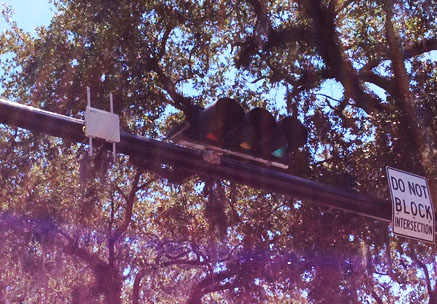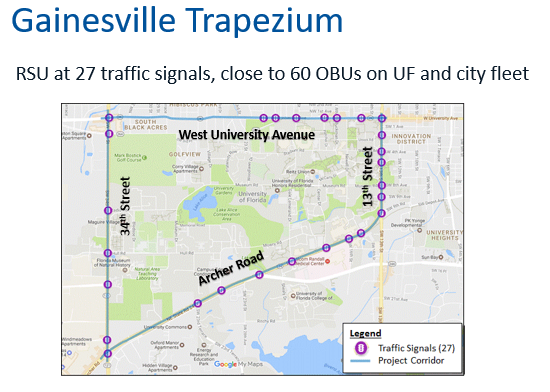
As part of the UFTI’s I-STREET initiative, a team of researchers at the University of Florida led by Dr. Sanjay Ranka, a Professor in the Department of Computer & Information Science & Engineering, in collaboration with the Florida Department of Transportation (FDOT), are working to evaluate connected vehicle (CV) technologies and applications installed by Siemens Mobility along four roads surrounding the UF campus in Gainesville, Florida.
Specifically, the technologies deployed by Siemens include Road-Side Units (RSUs) that are capable of Direct Short-Range Communications (DSRC). These were installed in Gainesville in the form of a trapezium along the routes of SR 121 (SW 34th St), SR 26 (W University Ave), US 441 (SW 13th St), and SR 24 (SW Archer Rd). The purpose for installing the technology was to alleviate traffic congestion, improve safety, provide traveler information, and to test connected vehicle (CV) and smartphone-based applications.
Traffic congestion is a major problem in urban areas in the United States leading to the purchase of $3.1 billion gallons of fuel and accounts for $160 billion in congestion costs. More specifically, traffic signals have contributed significantly to traffic delay, and about 40 percent of drivers spend at least 1 hour on the road each day. The technologies and applications installed along the trapezium have the potential to relieve congestion and improve safety.
To evaluate if the safety and operation objectives and benefits from the technology installed by Siemens Mobility (also known as the Gainesville Trapezium SPaT Project), are being achieved, Dr. Ranka and his research team will use crash data to assess safety benefits and measures such as travel time reliability, throughput, and delay. The research team will also develop a CV data archive and utilize CV data for evaluation of expected benefits and provide a framework of how to utilize that data for such deployments.

Dr. Ranka’s research group is currently finalizing the findings from “before” studies to assess the current traffic and safety conditions without the CV deployments. Now that the CV technologies have been deployed (i.e. RSUs and On Board Units or OBUs), the researchers will be assessing changes in the system with CV deployments over time. It is expected that safety and traffic operational benefits will be seen.
The project is also expected to generate a framework to assist transportation practitioners on how to utilize the CV data.
“The research team is developing a data management plan, which will include a data collection procedure, data storage, and a data retention policy,” said Dr. Pruthvi Manjunatha, who is the I-STREET Testbed Manager and a Research Assistant Professor at UF. “We are developing a framework on how to utilize CV data, and these procedures and the framework could be used as a guide for utilizing CV data in future deployments.”